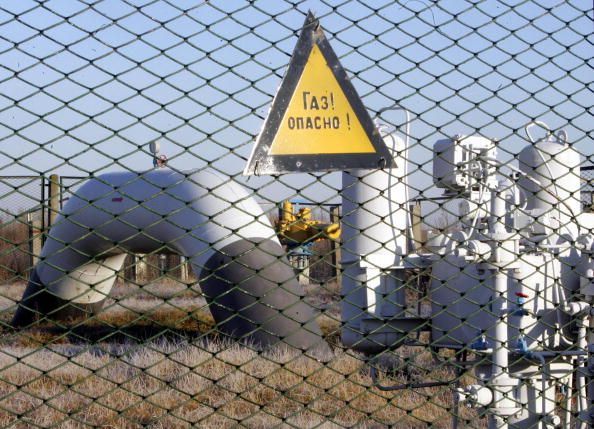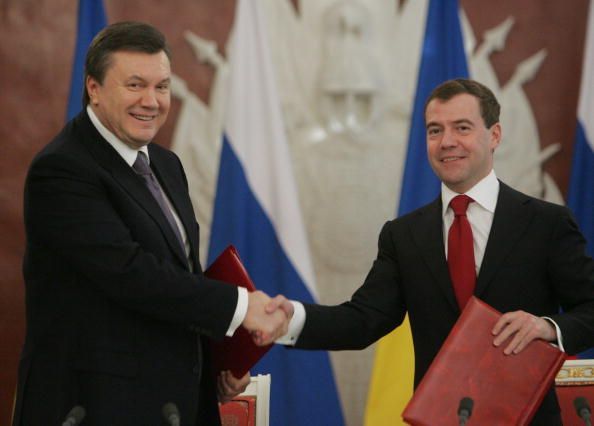«Нафтогаз» не будет продлевать контракт на транспортировку российского газа в Европу после того, как он завершится в конце 2024 года, заявил глава украинской компании Алексей Чернышов в интервью Радио Свобода.
Раньше это было ночным кошмаром для украинских чиновников, а теперь — прагматичным решением. Но означает ли это то, что транзит российского газа в Европу по территории Украины прекратится вообще?
Что будет в украинских трубах вместо российского газа? И что будет с самой газотранспортной системой? Ответ на эти вопросы искали в издании ВВС Украина.
Поле битвы первых «войн» с Россией

Построенная во времена Советского Союза украинская часть ГТС была рассчитана на экспорт в Европу огромных объемов газа.
На входе — восточной границе Украины — она могла бы принимать более 280 млрд кубов газа. На выходе — западной границе — эта система могла обеспечить экспорт почти 150 млрд кубов. Это в три раза больше, чем проектная мощность обеих веток «Северного потока» вместе взятых. И в пять раз больше, чем пропускная способность обеих веток «Турецкого потока».
Но после распада СССР между Украиной и Россией постоянно продолжались споры о ценах и долгах, а перекрытие газового вентиля постоянно было весомым рычагом российского влияния на украинскую политику.
Последний пример — Харьковские соглашения, по которым Украина при президенте Януковиче получила от России скидку на газ в обмен на продление базирования в Крыму российского флота.
Одновременно Россия последовательно строила трубопроводы в обход Украины — как на юге через Черное море («Турецкий поток»), так и на севере через Балтийское море («Северный поток»).
Транзит через Украину постоянно сокращался, но не прекратился. И тогда, когда Украина в ноябре 2016 года полностью отказалась от импорта газа из России, и даже с началом российского вторжения в феврале 2022 года.

Нынешний контракт на транспортировку российского газа в Европу «Газпром» и «Нафтогаз» подписали в конце 2019 года. Он был рассчитан на 5 лет и должен был принести Украине около 7 млрд долларов доходов. За 2022 — первый год войны — Украина получила за транзит около 1,2 млрд долларов. За первое полугодие 2023 года — около 700 млн долларов.
Однако, как говорит глава «Нафтогаза», «Газпром» недоплачивает по контракту, в котором четко указано: «качай или плати». По словам Алексея Чернышева, сейчас Украина получит «не более 70%» контрактной суммы.
«Газпром» не хочет платить за газ, который заходит через пункт пропуска в Сохранивцы. Оператор ГТС Украины отключил его от транзита из-за того, что после того, как эту территорию оккупировали россияне, украинская сторона не контролирует газоизмерительную станцию там. Эти недоплаты являются предметом очередного арбитража против «Газпрома».
Второй вход в украинскую ГТС — в Судже — работает. Именно он является одним из двух трубопроводных маршрутов, оставшихся у россиян для доставки своего газа в Европу. «Северный поток-2» так и не заработал, а первая ветка «Северного потока», ветка через Беларусь и одна из двух веток «Турецкого потока» прекратили работу.
Несмотря на то, что за время войны в Украине Европа кардинально уменьшила импорт газа из России, особенно поступающего по трубопроводам, — в 7 раз, по подсчетам Международного энергетического агентства, — в ЕС все еще есть страны, покупающие российский газ.
Словакия, Австрия, Венгрия — страны, не имеющие выходов к морю, — покупают газ, который идет через Украину. Как говорят они сами, им сложнее полагаться на сжиженный газ, поступающий в Европу через морские терминалы LNG.
Именно из солидарности с этими странами, говорит глава «Нафтогаза», Украина и в дальнейшем выполняет свои контракте обязательства и продолжает транспортировать российский газ, несмотря на российскую агрессию.
Но что будет, когда контракт на транспортировку завершится?
Что будет с транзитом?

Этот вопрос больше к ЕС и, в частности, к странам, которые до сих пор покупают российский газ, который транзитирует Украина, считает руководитель аналитического центра Dixi Group Елена Павленко.
Она напоминает, что одобренная ЕС программа REPower EU, предусматривает сокращение потребления ископаемого топлива, и прежде всего — российского газа, поступающего по трубопроводам. Если она и в дальнейшем будет внедряться такими же темпами, как сейчас, то «есть шансы, что в конце 2024 года не будет необходимости перезаключать договор ни с кем».
Если же в следующем году страны ЕС, которые все еще покупают российский газ, скажут, что не могут обойтись без него, теоретически возможно, что они будут заключать соглашения напрямую с «Газпромом». Украина не будет стороной этих соглашений, а европейские компании будут заказывать мощности украинской ГТС, предполагает Елена Павленко. При этом, добавляет она, очевидно, что это будут какие-то краткосрочные контракты, а точка приема газа перейдет на восточную границу Украины.
Собственно, так должно было быть еще в 2019 году, но тогда в ЕС не решились на такой шаг, сохранив гибридную форму, в которой остались старые отношения между «Нафтогазом» и «Газпромом», говорит Михаил Гончар, руководитель Центра глобалистики «Стратегия ХХI».
Теперь сама жизнь может заставить перейти к модели, на которой некоторое время настаивала Украина: европейский партнер «Газпрома» покупал бы газ на восточной границе Украины. А Украина имела бы контракт только с европейским клиентом.
«То есть отношений с «Газпромом» просто не было бы — они были бы не нужны», — объясняет эксперт по энергетической безопасности.
При этом, отмечает Михаил Гончар, важно отличать прекращение контракта на транзит в конце 2024 года от прекращения транзита Украиной, как пытаются подать эту новость в России. Он напоминает: уменьшение транзита через Украину всегда было инициативой России.
Эксперт предполагает, что Россия сама готовится прекратить поставки газа в Европу, по крайней мере, через территорию Украины. Но, добавляет Михаил Гончар, будет происходить это в присущей россиянам манере — не прямо, а как в 2006, 2009 годах, чтобы выставить виновной Украину.
Старая история о перекрытии вентиля на новый лад

Этот сценарий «наказания Европы», говорит эксперт, россияне подготовили еще с зимы 2021-22 года. Но для максимального эффекта нужны морозы.
«Они ждут каких-то аномальных холодов, когда Европе будет плохо, будет не хватать газа, и тогда произойдет перекрытие газового вентиля в направлении Украины, где осталась задействованной только одна нитка через Суджу, — прогнозирует эксперт. — Их цель — создать проблемы на европейском газовом рынке в условиях временного дефицита, и сделать виновной в этом Украину».
Если события будут развиваться таким образом, то восстановления транзита российского газа по территории Украины уже не будет. А украинская газотранспортная инфраструктура может подвергнуться прицельным российским обстрелам, которых она избежала, пока по украинским трубам шел газ в Европу. Впрочем, газовая инфраструктура менее уязвима к ракетным ударам, чем электроэнергетика, ведь большая часть труб находится под землей, а глубина подземных хранилищ составляет около полутора километров.
В пользу такого сценария, отмечает Михаил Гончар, свидетельствует усиленный интерес россиян к спутниковым снимкам территорий, где расположены объекты газовой инфраструктуры. Украина фиксирует такой интерес где-то с июня месяца, говорит эксперт.
Большие надежды

В том же интервью «Радио Свобода» глава «Нафтогаза» рассказал, что на украинскую ГТС ждут большие планы. Они связаны с большими газовыми запасами, — мол, если при нынешнем меньшем потреблении (из-за разрушения многих промышленных предприятий) удастся нарастить добычу, то избыток можно продавать за границу. Алексей Чернышов даже предположил, что со временем Украина может стать «нетто-экспортером» газа.
Но насколько реальны такие планы, даже если они касаются жизни «после войны»?
Пожелания, которые озвучил руководитель «Нафтогаза», предполагает Михаил Гончар, базируются на довоенных оценках потенциала Украины — до аннексии Крыма.
Он напоминает, что в 2012 году группа американских специалистов под эгидой минэнергетики США провели исследование потенциала добычи газа в Украине. Они учитывали залежи на Крымском шельфе, Юзовский и Олесский участки. По их оценкам, к 2030 году объем добычи украинского газа мог бы составить до 73 млрд кубов при том, что сейчас Украина добывает до 20 млрд кубов.

Это могло быть одним из факторов российской аннексии Крыма, предполагает эксперт. И в подтверждение своих мыслей приводит данные, как нарастили добычу газа на черноморском шельфе только двумя «вышками Бойко», — за несколько лет в разы.
Все эти проекты можно возобновить. Но есть одно условие. «Россия должна быть выброшена из Крыма, деоккупированным должен быть не только полуостров, но и морская акватория, принадлежащая Украине между Крымом и Одесской областью», — говорит Михаил Гончар, и добавляет, что то же касается и проектов на востоке Украины — в Донецкой и Харьковской областях.
Кроме того, нужен и еще один фактор — спрос на том конце трубы.
От голубого до «зеленого»

Если посмотреть на статистику, то потребление газа в ЕС в целом особо не уменьшилось, говорит Елена Павленко. Кардинально сократилось потребление российского трубопроводного газа, но за счет того, что европейцы переориентировались на Катар, Нигерию, США.
«Им удалось заместить российский газ газом другого происхождения, но я все еще не вижу, что они собираются радикально отказаться от газа в ближайшие годы», — говорит руководитель Dixi Group.
С тем, что газовая эпоха в ЕС далека от завершения, соглашается и Михаил Гончар.
«Мы и сейчас говорим, что угольная эра завершилась, но угольные станции работают все равно», — отмечает эксперт. А если учитывать климатические и зеленые цели ЕС, то газ является самым чистым из всех видов ископаемого топлива.
И здесь на стороне Украины может сыграть еще один джокер — биометан. Это практически тот же газ, добываемый из недр. Приставка био лишь указывает на его происхождение — из отходов животноводства или растениеводства, объясняет Михаил Гончар. Да, он должен быть специально подготовлен к запуску в сети, но технологически это вполне возможно.
Более того, в Украине уже существуют успешные проекты, связанные с биометаном.
Биометан вполне укладывается в концепцию зеленого перехода ЕС, и если его биологическое происхождение подтвердят соответствующие сертификаты, ЕС может быть очень заинтересован в его импорте. Но и здесь есть одно но. Это направление является очень жизнеспособным, но для его развития нужны изменения, время и деньги, говорит Елена Павленко.
Во-первых, говорит она, то производство биометана, которое уже есть в Украине, надо масштабировать — и быстро. А для этого нужны изменения в государственных регуляциях как в поддержку этого производства, так и поддержку экспорта. По ее данным, над этим уже работают и НКРЭКУ, и оператор ГТС.
Во-вторых, кто-то должен это финансировать и поддержать тот украинский бизнес, который пытается работать в этом направлении.
«Если ЕС готов хотя бы частично это финансировать, если европейские компании готовы заходить, и иметь какой-то совместный бизнес, то это перспективно», — говорит эксперт.
Впрочем, все это предположение на будущее. А что, если украинская ГТС не будет работать ни на транзит, ни на экспорт?
На металлолом?

Даже в этом случае «не все пропало», считает Михаил Гончар. В Украине добывают до 20 млрд кубов газа, что достаточно для покрытия внутренних потребностей. И чрезвычайно разветвленная система, которая может работать в обоих направлениях, будет доставлять этот газ к потребителям, хотя и их тоже стало меньше. Конечно, система, рассчитанная на перемещение 200 млрд кубов, не будет работать так же при транспортировке в десять раз меньших объемов. Придется поднять тарифы, оптимизировать работу и законсервировать определенные объекты, говорит Елена Павленко.
Но и здесь стоит рассмотреть все варианты и попытаться превратить минусы в плюсы. Например, газонасосные станции, ненужные при отсутствии транзита, можно использовать в электроэнергетике вместо маневровых мощностей угольных ТЭЦ, разрушенных Россией.
«Если эти газокомпрессорные станции оснастить генераторами, они станут производителями энергии», — считает Михаил Гончар.
Помочь может также и услуги по хранению газа, ведь для собственно украинских потребностей нужно лишь половина от объемов тех хранилищ, которые имеет Украина. Остальными могут пользоваться другие страны.
А если подземные хранилища снова объединить с трубопроводной системой, с которой они являются одним технологическим комплексом (и были разъединены лишь недавно во время анбандлинга «Нафтогаза»), то у оператора ГТС появятся дополнительные возможности зарабатывать деньги на хранении газа. Тогда тарифы на транспортировку можно поднимать не так резко, предполагает Михаил Гончар.
А то, что это вполне возможно и пользуется спросом, доказали не только последние довоенные годы, когда спрос на услуги украинских газовых хранилищ вырос, но и то, что даже во время войны некоторые иностранные компании хранят газ в украинских хранилищах — более 2 млрд кубов по состоянию на сейчас.


